Stop Learner Abuse Now
STOP LEARNER ABUSE SIGN THE PETITION!
The statistics provided by Marmalade, a well-known learner insurance provider, are highly concerning when it comes to dangerous driving behaviors around learner drivers. It has been observed that a whopping 81% of learner drivers face abuse from their fellow road users. As a consequence of such behavior, around 72% of the learners end up making more errors, thus putting the lives of everyone in danger. The study also revealed that approximately two-thirds of learners have fallen victim to tailgating and aggressive overtaking. Moreover, 44% have experienced being cut off while 59% have been subjected to excessive honking. These distressing experiences have caused around 49% of learners to pull over, while 8% have given up driving altogether.
In light of these facts and figures, it is high time to include reckless driving around learners as an aggravating factor that should lead to stronger sentences and greater deterrence. This would ensure road safety while protecting the vulnerable learner drivers who are still in the process of mastering this crucial life skill.








